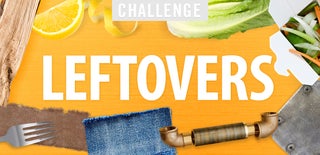Introduction: Pencil Case (and More) From Grocery Bag Plarn
Every household has them. Leftover grocery bags stuffed in each other, hidden in a cabinet. Sacks shoved in a dispenser with a horrible pattern like chickens (or in my case, peppers) and a few rouge ones stuck in random drawers. But what are you going to do with them all? Horde them for the upcoming bag-pocalypse? Save them in hopes of selling them one day like all those beanie babies in your closet? Use them as lunch sacks for the next 100 years? Why not make something that you can use with pride. If you do, consider voting for this project in the Leftover and Homemade Gift contests, that would be cool of you.
Anyone who knows me knows that there are three things I love in life; crafting, recycling, and saving money. When those three things collide, it's a match made in heaven. I recently discovered the technique for making "plarn" (plastic yarn) right around the time that my old pencil bag gave out. As the saying goes, necessity is the mother of invention, so I put my crochet skills to good use. The best things about this project are that it's free to make, durable, and a definite conversation starter. Here is how to do it:
Materials:
A Lot of Plastic Grocery Bags (seriously, a lot)
A Button (optional)
Tools:
Needle and Thread (optional- if you want the button closure)
Size H Crochet Needle
Scissors
Step 1: Creating the Plarn
First off, you have to make the yarn that you will be using. This is the most time consuming part of the project, but it is well worth it in the end. Grab a bag and fold it hot-dog style two or three times, then take your scissors and cut off the very end. Go up about an inch and cut and cut your first "loop", repeating the process until you reach the handles. Cut them off and discard them along with the bottom end.
Pro Tip: After you feel comfortable doing this, you can start stacking the bags on top of one another (five max.) before folding and cutting to save a lot of time.
After making quite a bit of loops, its time to join them. Open your first two loops then place them one over the other in the shape of a Venn Diagram. Take the inside of your bottom loop, fold it over the top loop, and slide it under the outside of itself. Slowly pull it and them repeat with all the other loops.
As you begin having a longer string, you can start wrapping it into a ball. To make a pencil bag, you need the ball to be about the size of your fist. If you find that you don't have enough bags, grab some unused trash bags to throw in the mix! It makes the pattern that much better when there is a variety of colors.
Step 2: Crochet the Bag
This pattern is so easy that an absolute beginner can do it. the only stitch that is required is a double crochet. For those of you unfamiliar with this stitch, Crochet Guru has a super easy tutorial for it that will make you a pro in no time!
For the pattern we will be making one solid rectangle that we will fold over on itself to join.
First, single crochet 23 stitches, then add two to turn for a total of 25 stitches.
Next, double crochet into the third stitch from the hook and continue double crocheting all the way down, this will complete your first row.
Repeat the process until you have 21 rows, then tie it off.
Step 3: Joining the Bag
Fold the bag onto itself, leaving five rows at the top of one side.
Then, using your yarn you can single crochet along the sides to seal it. If you are happy with the raw edge and don't want a button then you are done, however you can turn it inside out to give it a more professionally made look.
Step 4: Adding a Button
Fold the flap of the bag down and count down to the third row. Pull the flap back up and guesstimate the middle of the bag, then sew on the button. The yarn will be flexible enough for the button to slip through with ease. Click over to the next step to see how to make a laptop case using the same method.
Step 5: Beyond the Pencil Case
The possibilities with plarn are endless. So far I have also made a laptop case using the same style of pattern, the difference being the size of the hook and length of the pattern. For the larger bag I used a size Q hook, had 35 stitches and 30 rows.
I've had endless compliments on both, and have been able to start conversations on the benefits of reusing and recycling. Not bad for some free grocery bags!
If you enjoyed this tutorial, or made this project yourself, let me know!

Participated in the
Leftovers Challenge

Participated in the
Patterns Contest

Participated in the
Homemade Gifts Contest 2015










